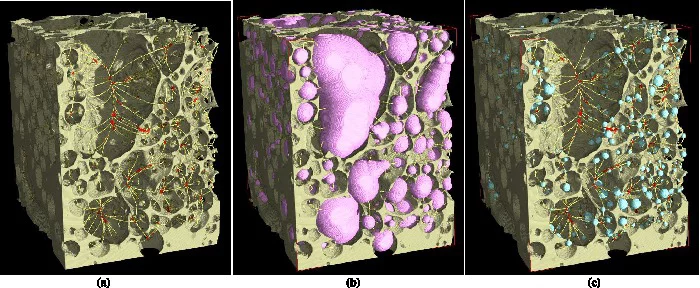Experiments performed at the Paul Scherrer Institute (PSI) investigate processes inside volcanic materials that determine whether a volcano will erupt violently or mildly.
In the experiments, an international team of scientists used a laser-based heating system to heat small pieces of volcanic material similarly to conditions present at the beginning of a volcanic eruption. They used X-rays from the Swiss Light Source (SLS) at the Paul Scherrer Institute (PSI) to observe, in real time, what happens to the rock as it goes from the solid to the molten state. A determining factor to the type of eruption that occurs is how fast gas bubbles form inside the material. These studies indicate that the type of eruption taking place may be established as early as the first few seconds of bubble growth. The researchers have published their results in the online journal Nature Communications.
Volcanic eruptions can vary from common, small eruptions that have little impact on humans and the environment to less common, large eruptions that have the potential to destroy a civilization. Although there are several factors that trigger volcanic eruptions, the release of trapped water and gases from molten rock is very important. As the molten rock ascends from the depths of the Earth, water (and other volatile substances) trapped inside form bubbles in the rock. These bubbles weaken the rock while simultaneously providing a pathway for the gas to escape in a process called “degassing”. If the bubbles expand more rapidly than the gas can escape, a volcanic eruption occurs; if the gas expands slowly, a more efficient degassing path is found, which allows the high-pressure gas in the bubbles to escape, reducing the volcanic hazard.
The formation and evolution of bubbles in molten basaltic rocks (such as those found around the Stromboli and Etna volcanoes in Italy) were the focus of a study performed by an international team of researchers led by Don Baker at McGill University (Canada). They performed the relevant experiments at the x-ray tomographic microscopy beamline (TOMCAT) of the Swiss Light Source at the Paul Scherrer Institute. “Using the laser-based heating system I recently developed alongside the ultra-fast endstation at TOMCAT, we were able to capture the microstructural changes in three dimensions and in real time. This means that we saw, for one of the first times, the bubble evolution inside a small piece of basaltic melt at each second during the beginnings of bubble growth”, explains Julie Fife, the PSI scientist from the TOMCAT beamline on the research team. The researchers then determined which conditions of bubble formation led to failure in the rock.
“Understanding the intricate interplay between failure strength and increasing permeability during the very initial formation of bubbles in molten rocks suggests that the combination of these variables controls whether a volcano erupts explosively or just quietly vents its gas and produces small eruptions”, explains Baker.
Perhaps the most important finding from this research suggests that one of the most explosive types of eruptions, a Plinian eruption, is likely to occur within the first 10 seconds of bubble evolution. The rapid increase in the number of bubbles leads to a decrease in the rock strength and ultimately causes catastrophic failure of the sample. If the magma does not erupt immediately, the pathways for degassing may develop enough to lower the threat of failure and eruption. These studies are a small but important step toward the ultimate goal of predicting the types of eruptions that can occur in various volcanic regions throughout the world.
Text by Julie L. Fife and Don Baker
About PSI
The Paul Scherrer Institute develops, builds and operates large, complex research facilities, and makes them available to the national and international research community. The Institute's own key research priorities are in the investigation of matter and material, energy and the environment; and human health. PSI is Switzerland's largest research institution, with 1500 members of staff and an annual budget of approximately 300 million CHF.
Contact
Don R. Baker, Earth and Planetary SciencesMcGill University, Montreal QC, H3A2A7, Canada
Phone: +1 514 398 7485; E-mail: don.baker@mcgill.ca
Julie L. Fife, Swiss Light Source
Paul Scherrer Institute, 5232 Villigen PSI, Switzerland,
Phone: +41 56 310 58 40; E-mail: julie.fife@psi.ch
Original publication
A 4D x-ray tomographic microscopy study of bubble growth in basaltic foamDon R. Baker, Francesco Brun, Cedrick O'Shaughnessy, Lucia Mancini, Julie L. Fife, Mark Rivers
Nature Communications , 16 October 2012 DOI: 10.1038/ncomms2134

